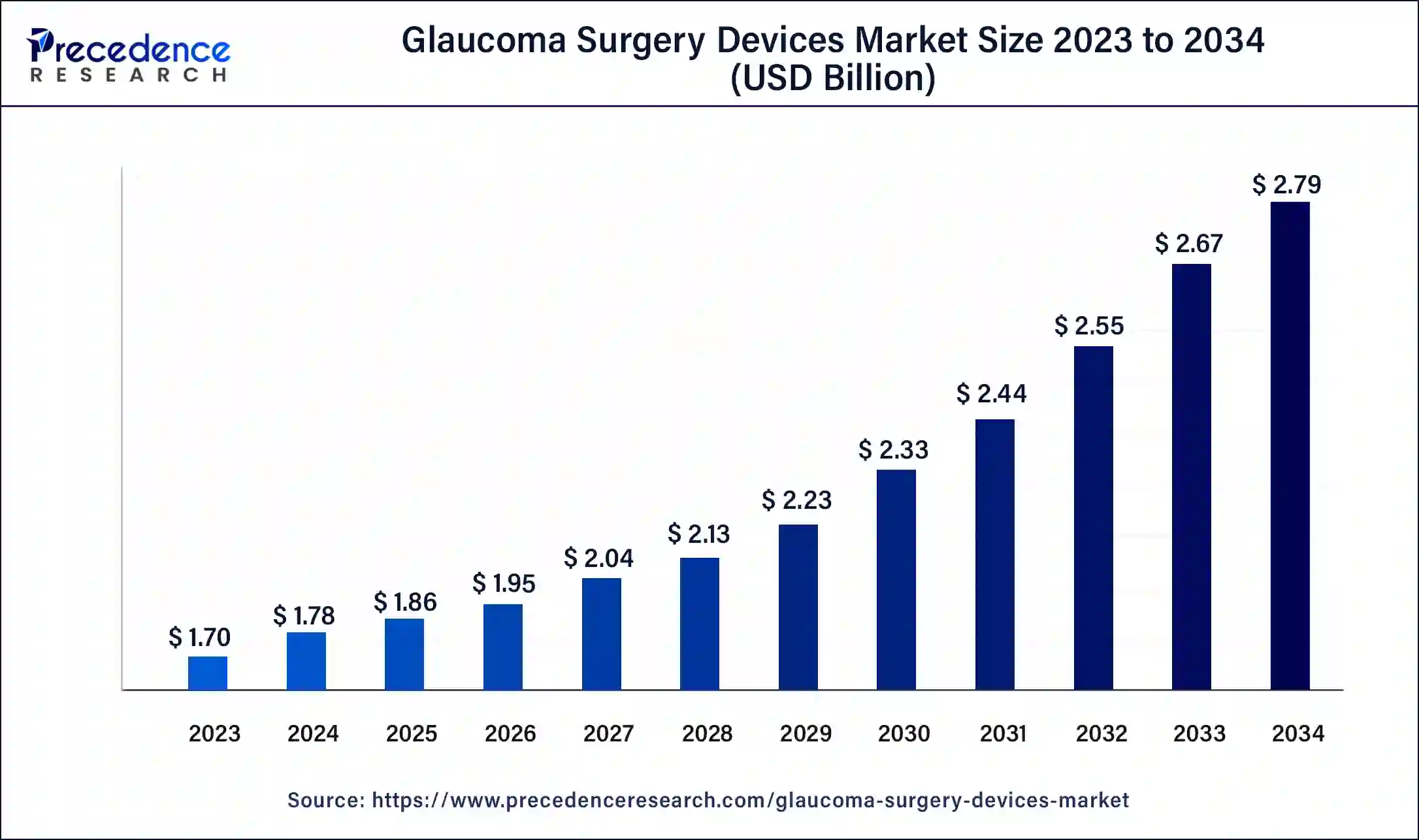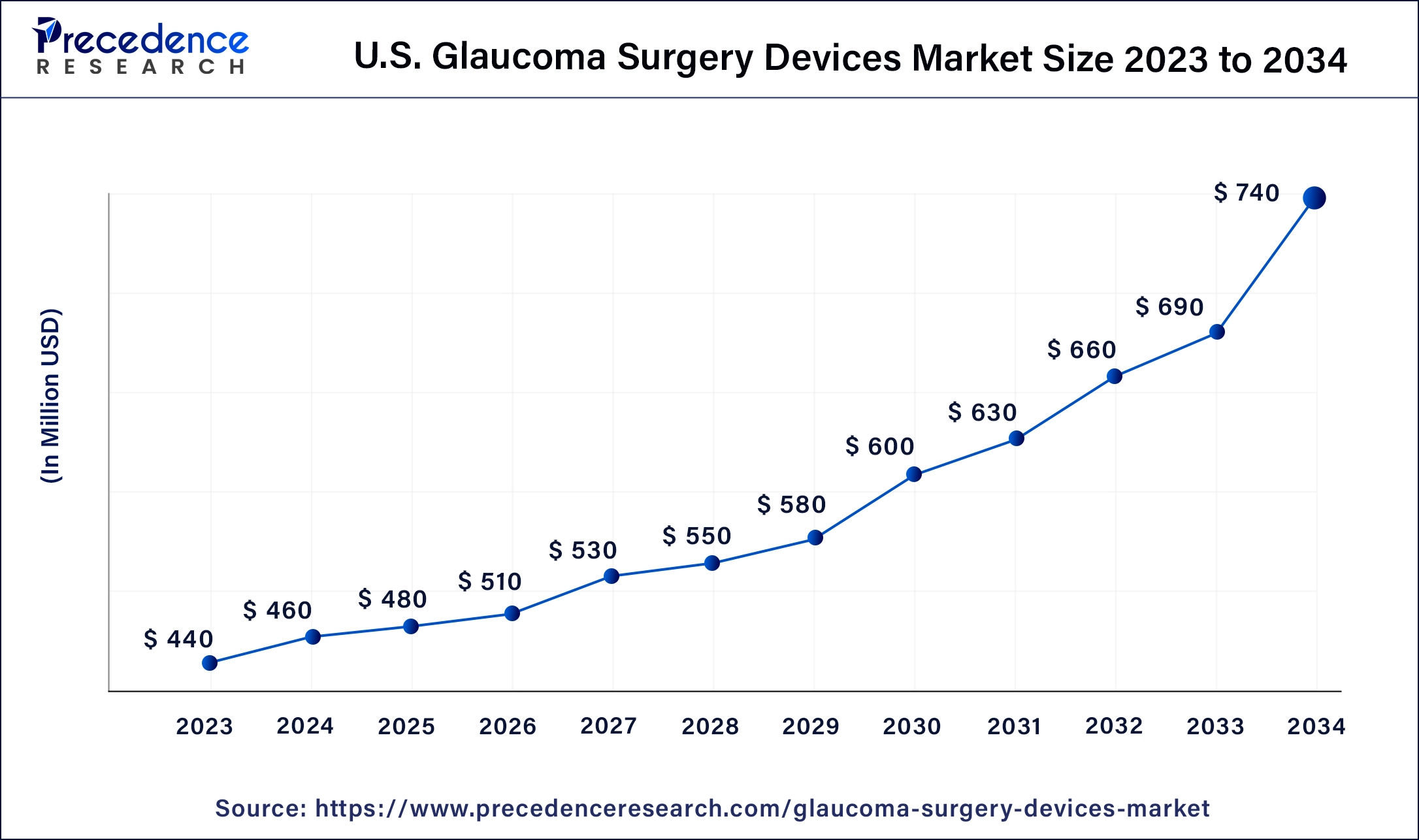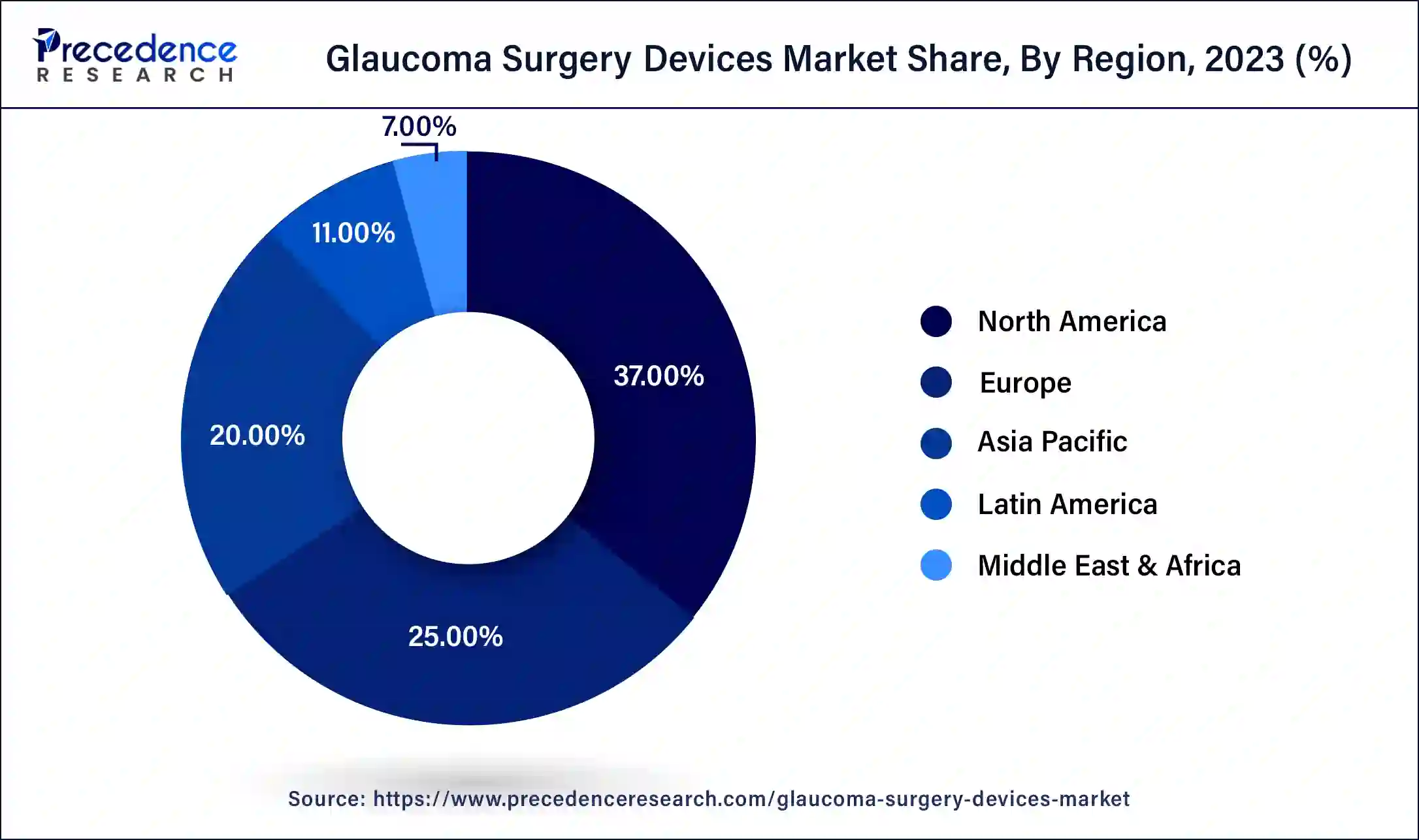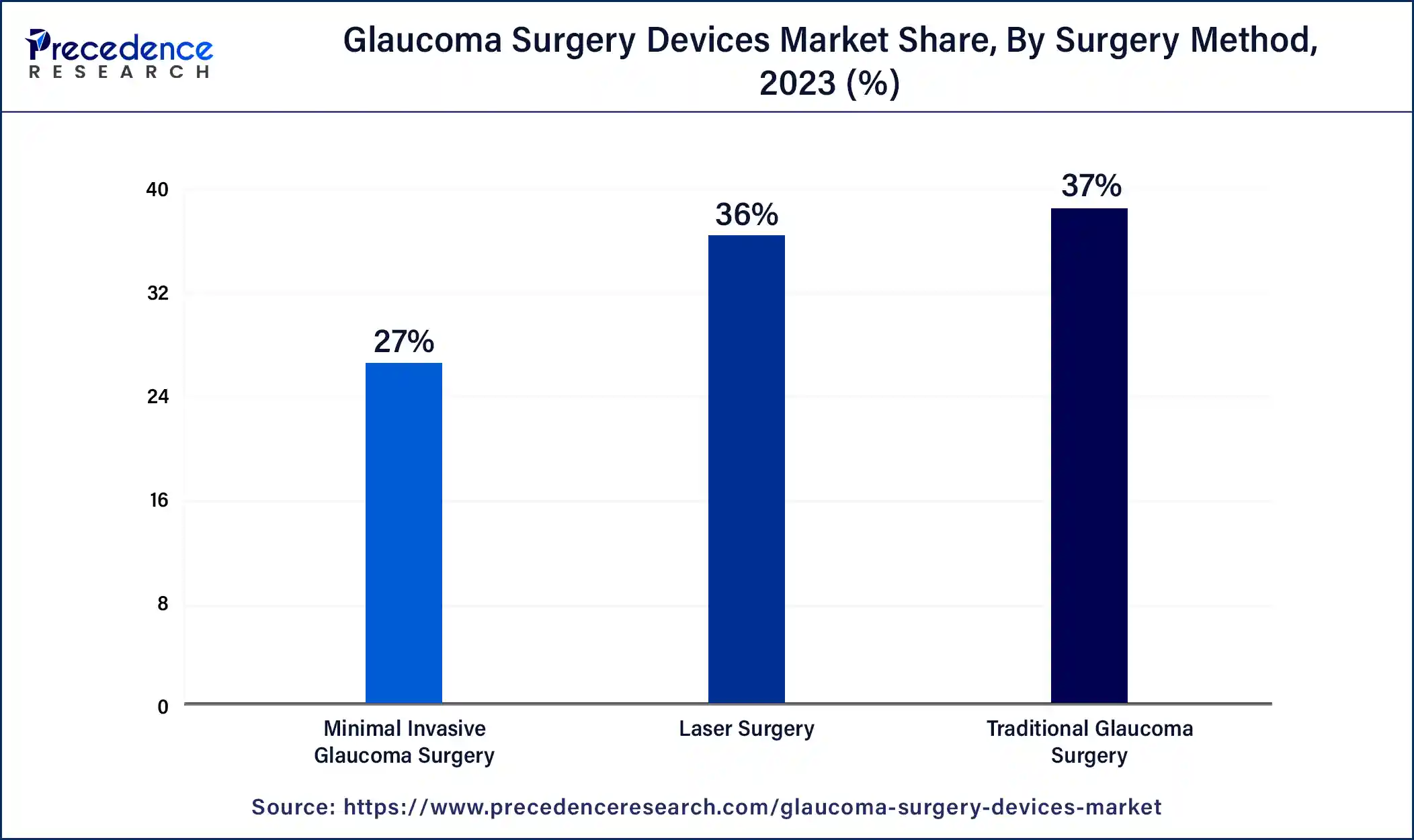March 2024
The global glaucoma surgery devices market size was USD 1.70 billion in 2023, calculated at USD 1.78 billion in 2024 and is expected to reach around USD 2.79 billion by 2034, expanding at a CAGR of 4.62% from 2024 to 2034.
The global glaucoma surgery devices market size is worth around USD 1.78 billion in 2024 and is anticipated to reach around USD 2.79 billion by 2034, growing at a CAGR of 4.62% over the forecast period 2024 to 2034. The glaucoma surgery devices market is experiencing growth due to factors like increasing prevalence, rising geriatric populations, advancement in technology, and rising awareness about glaucoma.

The U.S. glaucoma surgery devices market size was valued at USD 440 million in 2023 and is expected to be worth around USD 740 million by 2034, rising a CAGR of 4.83% from 2024 to 2034.

North America held the largest share of the glaucoma surgery devices market in 2023 and is expected to sustain its position throughout the forecast period. North America has been the leading region in the market, driven by high awareness of the disease, advanced healthcare infrastructure, and substantial investments in research and development. The American Glaucoma Society (AGS) is a leading organization focused on enhancing the lives of individuals with glaucoma and those at risk by advancing education, research, healthcare access, and advocacy.

Asia Pacific is anticipated to witness the fastest growth in the glaucoma surgery devices market during the forecast period. The increasing prevalence of glaucoma, driven by aging populations and lifestyle changes, is increasing the demand for advanced diagnostic and treatment technologies. The expanding healthcare infrastructure and growing investments in ophthalmic research and development contribute to the market expansion. Countries like India, China, and Japan are particularly significant in this growth trend.
Glaucoma is a chronic, progressive ocular condition that affects the optic nerve and can lead to irreversible vision loss. It is often referred to as the ‘silent thief of sight’ because it slowly damages the optic nerve before causing noticeable central vision loss. The device is used to treat mild to moderate glaucoma and is approved for implantation during phacoemulsification. These devices include those designed to enhance outflow as well as sustained-release drug delivery systems and extraocular devices that aim to reduce glaucomatous progression through the novel method. The glaucoma surgery devices market is expanding due to several key factors.
Impact of AI on the Glaucoma Devices Market
The integration of artificial intelligence in the glaucoma surgery devices market is rapidly transforming the fields. AI technology enhances the capabilities of glaucoma devices by improving diagnostic accuracy and reducing the need for manual intervention. Artificial intelligence can significantly reduce the need for manual labor and improve the efficiency of classified treatment systems, enabling earlier diagnosis and treatment of more patients. Notable success in both diagnostic and prognostic aspects. An ideal AI system for glaucoma should comprehensively assess all relevant parameters, including intraocular pressure, disc morphology, gonioscopy, visual fields, and OCT.
| Report Coverage | Details |
| Market Size by 2034 | USD 2.79 Billion |
| Market Size by 2024 | USD 1.78 Billion |
| Market Growth Rate from 2024 to 2034 | CAGR of 4.62% |
| Largest Market | North America |
| Base Year | 2023 |
| Forecast Period | 2024 to 2034 |
| Segments Covered | Product, Surgery Method, End-use, and Region |
| Regions Covered | North America, Europe, Asia-Pacific, Latin America and Middle East & Africa |
Increasing prevalence of glaucoma
The rising prevalence of eye disorders, particularly glaucoma, is a growing concern in the glaucoma surgery devices market. Glaucoma refers to a group of progressive optic neuropathies that involve the degeneration of retinal ganglion cells and the retinal nerve fiber layer, leading to changes in the optic nerve head. It is a leading cause of irreversible vision loss globally. Although advances in imaging and visual field testing have improved early diagnosis and treatment, many patients remain undiagnosed until the disease has significantly progressed. This delay can result in irreversible vision loss and diminished quality of life.
Increasing geriatric population
The increasing prevalence of glaucoma, particularly among the geriatric population, is a major factor driving the glaucoma surgery devices market, as this age group is at a significantly higher risk for the disease. Adults over 60 are six times more likely to develop glaucoma, especially if a parent or sibling has the condition. Additionally, certain groups, such as African Americans and Hispanic Americans, are disproportionately affected and face increased risk as they age. Age significantly influences the impact of intraocular pressure on glaucomatous damage to the retinal nerve fiber layer, with older patients often experiencing more rapid progression.
The Global Burden of Diseases, Injuries, and Risk Factors Study reported that the age-standardized prevalence of glaucoma was approximately 3-5% in the population aged 40 years and older worldwide. This figure was expected to rise to 112 million people by 2040 due to the rapid increase in global population aging.
The economic burden associated with glaucoma
The significant economic burden associated with glaucoma, particularly as the disease progresses, presents a restraint for the glaucoma surgery devices market. With an estimated 3% of the global population over 40 years affected by glaucoma, many of them remain undiagnosed, and the overall costs associated with advanced stages of the disease can be substantial. As glaucoma progresses, direct medical costs increase, impacting healthcare budgets and patient finances. This economic strain can limit access to advanced glaucoma devices, especially for patients in lower income brackets or regions with less robust healthcare systems. Furthermore, the need for early diagnosis and ongoing treatment adds to the financial burden, potentially constraining market growth for new and innovative glaucoma surgical solutions.
Rising awareness
Rising awareness about glaucoma presents a significant opportunity for the glaucoma surgery devices market. Increased public understanding of the importance of regular eye check-ups, knowledge of family medical history, and adopting healthy lifestyles can lead to earlier detection and intervention. As more individuals become aware of glaucoma’s risks and the necessity for timely treatment, there is a growing demand for advanced glaucoma devices. Early detection and proactive management can drive the market. Enhanced awareness also supports greater adoption of new technologies and processes, ultimately improving patient outcomes and expanding market potential.
The traditional surgery devices segment held the largest share of the glaucoma surgery devices market in 2023. The traditional surgery devices market is dominated by traditional surgery methods, which have widespread applications. The increase in success rate for glaucoma surgery and the lower treatment costs of traditional glaucoma surgery contribute to its dominance. In underdeveloped economies, conventional glaucoma surgery is preferred as the first-line treatment due to its affordability compared to other segments.
The diamond knives segment is expected to grow significantly in the glaucoma surgery devices market during the forecast period. Diamond knives offer significant advantages over traditional blades in surgical techniques. Scanning electron microscopy has demonstrated that incisions made with diamond knives cause minimal corneal epithelium and stroma disruption, promoting better healing and less postoperative discomfort. Many surgeons prefer diamond knives because they often result in improved surgical outcomes and fast patient recovery times.
The traditional glaucoma surgery segment is expected to dominate the glaucoma surgery devices market in 2023. Its long-standing efficacy and widespread use have driven the market growth. Trabeculectomy, a key procedure in this segment, has been the gold standard for managing advanced glaucoma or cases unresponsive to medical or laser treatment. Despite the emergence of newer techniques, such as the Ex-PRESS glaucoma shunt, which offers a less invasive option and often achieves rapid pressure stabilization, traditional surgery continues to dominate the market due to its extensive history of successful outcomes.

The minimally invasive glaucoma surgery segment is observed to grow at a significant rate in the glaucoma surgery devices market during the forecast period. MIGS techniques, such as Hydrus stent, iStent, and XEN implant, offer rapid visual recovery, high safety, and minimal tissue trauma, making them appealing to both patients and surgeons. MIGS represents a promising, less invasive alternative in glaucoma management with evolving long-term results.
The hospital segment led the global glaucoma surgery devices market in 2023. This leadership is largely attributed to the comprehensive care provided in hospital settings, where complex procedures such as glaucoma drainage implant surgeries are performed. The specialized resources, advanced technology, and multidisciplinary teams available in hospitals contribute to their prominence in the glaucoma surgery market.
The ophthalmic clinics segment is expected to witness the fastest growth in the glaucoma surgery devices market during the projected period. This growth is driven by the increasing demand for specialized, accessible, and cost-effective glaucoma treatment. Ophthalmic clinics offer focused expertise in managing glaucoma, including advanced minimally invasive procedures and regular follow-up care.
Segments Covered in the Report
By Product
By Surgery Method
By End-user
By Geography
For inquiries regarding discounts, bulk purchases, or customization requests, please contact us at sales@precedenceresearch.com
No cookie-cutter, only authentic analysis – take the 1st step to become a Precedence Research client
March 2024
October 2024
April 2025
March 2025